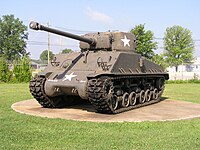
Photo from wikipedia
Abstract The side wall effect was normally tackled by potential flow based numerical methods. It is well known that, due to the existence of the resonance frequency in the wave… Click to show full abstract
Abstract The side wall effect was normally tackled by potential flow based numerical methods. It is well known that, due to the existence of the resonance frequency in the wave tank, the numerical methods over-predict the hydrodynamic forces when comparing with model experiments. Furthermore, in most of the previous studies on the effects of the side walls, the model was located at the centre of the tank, the disturbances on both sides of the model are symmetric, and the resonances of some of the responses such as wave surface elevation and motions may not be excited at the tank natural frequencies. In the present study, a Rankine source panel method is used to tackle the effects of the side walls and artificial damping is introduced in the free surface boundary condition to account for the viscous damping effect. Model experiments are carried out for a lifeboat model located at various positions in a wave flume. Numerical results of the wave forces, free surface elevations and motions of the model are compared with the model test measurements, and good agreement is found. It is shown that the inclusion of the artificial damping in the free surface boundary condition is effective, in particular for the model at off-centre position of the tank.
Journal Title: Ocean Engineering
Year Published: 2019
Link to full text (if available)
Share on Social Media: Sign Up to like & get
recommendations!